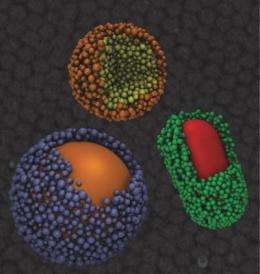Engineers discover nanoscale balancing act that mirrors forces at work in living systems

(PhysOrg.com) -- A delicate balance of atomic forces can be exploited to make nanoparticle superclusters that are uniform in size---an attribute that's important for many nanotech applications but hard to accomplish, University of Michigan researchers say.
The same type of forces are at work bringing the building blocks of viruses together, and the inorganic supercluster structures in this research are in many ways similar to viruses.
U-M chemical engineering professors Nicholas Kotov and Sharon Glotzer led the research. The findings are newly published online in Nature Nanotechnology.
In another instance of forces behaving in unexpected ways at the nanoscale, they discovered that if you start with small nanoscale building blocks that are varied enough in size, the electrostatic repulsion force and van der Waals attraction force will balance each other and limit the growth of the clusters. This equilibrium enables the formation of clusters that are uniform in size.
"The breakthrough here is that we've discovered a generic mechanism that causes these nanoparticles to assemble into near perfect structures," Glotzer said. "The physics that we see is not special to this system, and could be exploited with other materials. Now that we know how it works, we can design new building blocks that will assemble the same way."
The inorganic superclusters---technically called "supraparticles"---that the researchers created out of red, powdery cadmium selenide are not artificial viruses. But they do share many attributes with the simplest forms of life, including size, shape, core-shell structure and the abilities to both assemble and dissemble, Kotov said.
"Having these functionalities in totally inorganic system is quite remarkable," Kotov said. "There is the potential to combine them with the beneficial properties of inorganic materials such as environmental resilience, light adsorption and electrical conductivity."
Zhiyong Tang, a collaborating professor at the National Center of Nanoscience and Technology in China, said, "It is also very impressive that such supraparticles can be further used as the building blocks to fabricate three-dimensional ordered assemblies. This secondary self-assembly behavior provides a feasible way to obtain large-scale nanostructures that are important for practical application."
Kotov is currently working on "breeding" these supraparticles to produce synthetic fuels from carbon dioxide. The work also has applications in drug delivery and solar cell research and it could dramatically reduce the cost of manufacturing large quantities of supraparticles.
"By replicating the self-assembly processes that allow living organisms to grow and heal, we can simplify the production of many useful nanostructured systems from semiconductors and metals so much so that they can be made in any high school laboratory," Kotov said.
Provided by University of Michigan
















